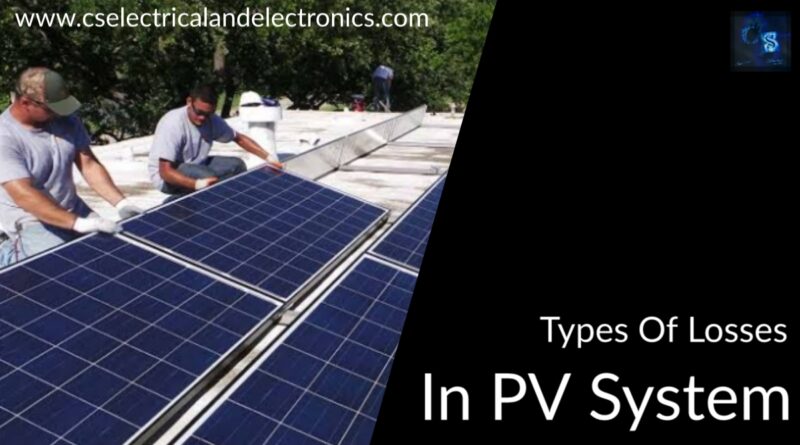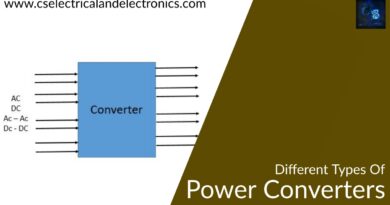Types Of Losses In PV System, Photovoltaic Losses, PV Losses
Hello guys, welcome back to my blog. In this article, I will discuss the types of losses in PV system, photovoltaic losses or PV losses, and why we have to consider the solar photovoltaic losses.
If you have any doubts related to electrical, electronics, and computer science, then ask questions. You can also catch me on Instagram – CS Electrical & Electronics And Chetan Shidling.
Also, read:
- Top Electric Vehicle Charging Station Installing Companies In The World
- Different Types Of Lithium-Ion Batteries, Working, Applications
- Fuel Cell Working, Applications, Types, Advantages, Disadvantages
Types Of Losses In PV System
The losses arising in the field process of a PV generator have to be evaluated in order to estimate exactly its real electric power output. The subsequent losses have to be brought into account.
01. Soling Losses: The efficiency of the PV solar systems is mainly dependent on the ambient conditions and various factors come into the picture to decide the actual efficiency of panels during their process. One such aspect is soiling. In easy words, soiling represents the accumulation of dust and soil particles over the solar panels. Yet, in a practical sense, the definition of soiling could be considerably wider than that.
For example, multiple researchers concluded from their research that bird droppings can seriously bring down panel efficiency, and therefore, they are also thought while estimating the soiling losses. Multiple times, the water or the mixture of cleaning agents and water utilized to clean the panels leaves behind a layer on the panels. This can also be called a condition of soiling.
02. Reflection Losses: when the incidence curve of the solar radiation varies from the vertical direction on the cover of a PV generator, reflection failures happen which will generate an overestimation of the PV system under field situations. These losses are decreased by coating the exterior with an antireflection layer.
03. Spectral Losses: solar radiation is represented by a broad spectral distribution because the Air Mass (AM) value shifts during the daytime. Solar radiation includes photons with quite distinct energies. Photons with less energy than the bandgap energy are not absorbed and therefore are unused. In the matter of photons with more extensive energy than the bandgap energy, just an amount of energy similar to the bandgap energy is valid, yet of the value of a photon’s energy. The extra energy is just dissipated as heat into the crystal lattice.
04. Mismatch Losses: the I-U factor of PV modules from the exact type and the same manufactory can differ from one module to another. According to the details of the suppliers, the MPP of a module under STC can shift up to 10% from the datasheet features. By series and parallel combinations of the modules in a PV generator, the various I-U characteristics will deliver power losses which are named mismatch losses.
For instance, for quantifying the mismatch losses, measures were conducted in which the PV generator was created up of 36 identical modules and then compared with estimates in which the manufactory parameters of the particular 36 modules were utilized, and the results indicated mismatch losses of about 3%.
05. Shadowing Losses: the features of the PV generators are influenced by the existence of partial shadowing particularly the value of maximum result power, the fill factor, and the efficiency of the PV system. Thus, it is very essential to choose the right site for the PV generator to control partial shadowing during the process of the PV system.
06. External losses: in a real system, the PV generator’s resulting power is not precisely equal to the input power to the connected power conditioning unit. In order to compute this input power, the losses generated by the voltage drop due to line resistance and the blocking diodes have to be regarded. The losses generated by the resistance of the connecting lines(ohmic losses) from the PV system have to be estimated based on lines length and diameter. This resistance is regarded as a series resistance of the PV model.
In each string that forms the PV generator, blocking diodes are linked in series with these strings. If a short circuit happens in one or more additional of these strings, the blocking diodes will control the currents to flow from the ideal strings to the faulty strings. During the process, there is a voltage drop via each diode of about 0.7V. This matter has to be subtracted from the resulting voltage of the PV system.
This was about “Types Of Losses In PV System“. I hope this article may help you all a lot. Thank you for reading.
Also, read:
- 10 Tips To Maintain Battery For Long Life, Battery Maintainance
- 10 Tips To Save Electricity Bills, Save Money By Saving Electricity
- 100 (AI) Artificial Intelligence Applications In The Automotive Industry
- 100 + Electrical Engineering Projects For Students, Engineers
- 1000+ Control System Quiz, Top MCQ On Control System
- 1000+ Electrical Machines Quiz, Top MCQs On Electrical Machines
- 1000+ MATLAB Simulink Projects For MTech, Engineering Students
- 50 Tips To Save Electricity At Home, Shop, Industry, Office
Author Profile
- Chetu
- Interest's ~ Engineering | Entrepreneurship | Politics | History | Travelling | Content Writing | Technology | Cooking
Latest entries
 All PostsApril 19, 2024What Is Vector CANoe Tool, Why It Is Used In The Automotive Industry
All PostsApril 19, 2024What Is Vector CANoe Tool, Why It Is Used In The Automotive Industry All PostsApril 13, 2024What Is TCM, Transmission Control Module, Working, Purpose,
All PostsApril 13, 2024What Is TCM, Transmission Control Module, Working, Purpose, All PostsApril 12, 2024Top 100 HiL hardware in loop Interview Questions With Answers For Engineers
All PostsApril 12, 2024Top 100 HiL hardware in loop Interview Questions With Answers For Engineers All PostsMarch 22, 2024Driver Monitoring Systems In Vehicles, Working, Driver Sleepy Alert
All PostsMarch 22, 2024Driver Monitoring Systems In Vehicles, Working, Driver Sleepy Alert








